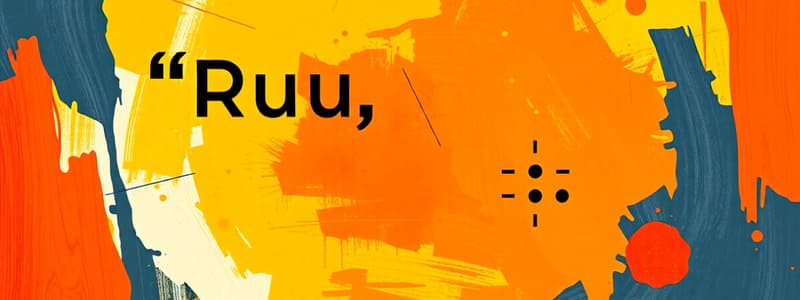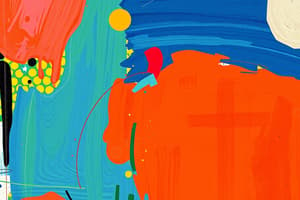Podcast
Questions and Answers
A student argues that a hypothetical article about climate change primarily aims to persuade readers to adopt more sustainable lifestyles. Which of the following excerpts from the article would most effectively support this argument?
A student argues that a hypothetical article about climate change primarily aims to persuade readers to adopt more sustainable lifestyles. Which of the following excerpts from the article would most effectively support this argument?
- "Implementing renewable energy sources and reducing personal carbon footprints are crucial steps towards mitigating the effects of global warming." (correct)
- "Scientific data indicates a clear warming trend over the past century, with significant ice cap melting observed in polar regions."
- "Historical records show cyclical patterns of climate variation, suggesting natural factors also contribute to environmental change."
- "Economic analyses reveal the potential costs associated with both climate change impacts and the transition to green technologies."
Imagine you are reading an article detailing the history of the internet. The article explains how ARPANET was initially designed for academic and military research. If you were asked to predict how the internet might evolve in the next decade based on this historical context, which prediction would be the most consistent application of the information?
Imagine you are reading an article detailing the history of the internet. The article explains how ARPANET was initially designed for academic and military research. If you were asked to predict how the internet might evolve in the next decade based on this historical context, which prediction would be the most consistent application of the information?
- The internet's development will stagnate due to a lack of further groundbreaking technological innovations.
- The internet will likely continue to democratize information access and foster collaborative research environments globally. (correct)
- The internet will primarily be used for entertainment and social media, overshadowing its research and academic roots.
- The internet will become exclusively controlled by governments for national security purposes.
Consider an article structured with an introduction outlining a problem, followed by three paragraphs detailing different proposed solutions, and concluding with a summary paragraph recommending one solution. What is the primary function of the three paragraphs in the middle of this article's structure?
Consider an article structured with an introduction outlining a problem, followed by three paragraphs detailing different proposed solutions, and concluding with a summary paragraph recommending one solution. What is the primary function of the three paragraphs in the middle of this article's structure?
- To offer personal anecdotes and emotional appeals to engage the reader with the problem.
- To present and elaborate on various potential approaches to address the problem. (correct)
- To provide background information and historical context related to the problem introduced.
- To argue against the existence of the problem stated in the introduction.
An article claims that increased screen time is the primary cause of declining attention spans in teenagers. Which question would be most effective in critically evaluating the reasoning and support for this claim?
An article claims that increased screen time is the primary cause of declining attention spans in teenagers. Which question would be most effective in critically evaluating the reasoning and support for this claim?
An article describes a series of events leading to the outbreak of a fictional 'Resource War'. These events include: increased global population, depletion of key natural resources, and rising international tensions. What is the most likely underlying factor connecting these events that led to the war?
An article describes a series of events leading to the outbreak of a fictional 'Resource War'. These events include: increased global population, depletion of key natural resources, and rising international tensions. What is the most likely underlying factor connecting these events that led to the war?
Flashcards
Quoting from a Text
Quoting from a Text
Citing exact phrases or passages from a written work.
Applying Information
Applying Information
Using knowledge learned to solve problems or analyze situations.
Structure and Meaning
Structure and Meaning
How the organization of a text influences its interpretation.
Analyzing Events and Ideas
Analyzing Events and Ideas
Signup and view all the flashcards
Seeing the Role of Graphics in a Text
Seeing the Role of Graphics in a Text
Signup and view all the flashcards
Study Notes
Quoting from a Text
- Accurate and complete quotation is crucial for avoiding misrepresentation.
- Ensure quotation marks are used correctly around direct quotes.
- Include the entire quoted passage if necessary to understand its context.
- Include a citation, including author, title, and page number, for proper attribution.
- Paraphrasing is an alternative to direct quotation when the focus is on conveying meaning rather than exact wording.
- Use your own words to summarize an idea or passage while maintaining the original thought.
- Context is key; the surrounding information should be considered when quoting or paraphrasing.
Applying Information
- Applying information involves using the knowledge gained from a text to solve problems, make decisions, or create something new.
- This skill builds on comprehension and involves using what you've read to answer questions, identify solutions to real-world problems, or make logical inferences.
- Application can involve creating a plan of action based on a presented solution or deciding on a possible outcome based on the available evidence within the text.
- This process requires actively connecting the text's information to your own understanding and experiences.
Structure and Meaning
- Recognizing the author's purpose and intended meaning is essential for comprehending a text.
- Analyzing the organization of a text (e.g., chronological order, cause-and-effect relationships, comparison/contrast) reveals its underlying structure.
- Understanding the author's background, audience, and context enriches the analysis of the text's meaning.
- Tone, style, and language choices contribute to the overall meaning and impact of the text.
- Examining the organization, structure, and vocabulary used in the text provide clues to its meaning.
Checking Reasoning and Support
- Evaluating the reasoning and evidence used by the author is vital for forming a critical perspective.
- Identifying the author's claims and the supporting evidence presented strengthens comprehension.
- Critically evaluating the logic of the reasoning is important to determine if the conclusions are justified by the evidence.
- Determining the strengths and weaknesses of the supporting evidence enables effective analysis of the claims.
- Examining biases and assumptions implicit in the text is crucial for a comprehensive understanding.
Analyzing Events and Ideas
- Analyzing events involves examining the causes, effects, and context of a historical situation, narrative, or societal event described in the text.
- Analyzing ideas requires a deep understanding of the concepts discussed and how they relate to broader themes or issues.
- Identifying key ideas and examining their development allows for a comprehensive perspective.
- Categorizing ideas and events helps to structure the analysis.
- Determining the significance and impact of the events or ideas being examined helps to form a comprehensive understanding.
Comparing and Contrasting Accounts
- Comparing and contrasting various accounts of an event provides a more comprehensive picture.
- Identifying similarities and differences in presented narratives or viewpoints of the same event or idea enriches understanding.
- Evaluating the credibility of each source is an important part of the contrasting process.
- Identifying potential biases or perspectives in each account shapes a more nuanced understanding.
Seeing the Role of Graphics in a Text
- Graphics, including charts, graphs, images, and illustrations, in a text play an essential role in enhancing comprehension and engagement.
- Understanding the way visuals contribute to the understanding of the overall text is important.
- Graphics can present data concisely, highlighting key trends or patterns.
- Images can provide visual representation of concepts, events, or ideas described in the text.
- Figures and illustrations can reinforce or clarify the text's content visually.
Studying That Suits You
Use AI to generate personalized quizzes and flashcards to suit your learning preferences.
Description
Learn the proper techniques for quoting text accurately and completely while avoiding misrepresentation and plagiarism. Understand the effective use of paraphrasing to convey meaning while maintaining original thought. Discover how to apply information from texts to solve problems and make informed decisions.




